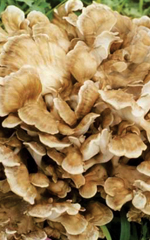
Maitake Mushroom (Grifola frondosa)
 Maitake Mushroom (Grifola frondosa)
Maitake Mushroom (Grifola frondosa)
Maitake is an edible and medicinal mushroom grows in the northern part of the Temperate Zone in the Northern Hemisphere found in Japan, China, Europe and North America. Wild Maitake can be harvested in September and October. It forms large hands, mainly near the roots of big fagaceous trees such as white oak, beech, and tanbark oak. It grows in persimmon, plum, apricot, Prunus ume and oak trees. It invades the core of these trees. It decomposes lignin and leaves the cellulose, which is the cause of so-called white rot.
Wild Maitake has a good taste, a crisp texture, and an excellent aroma. It is considered the first-rank edible mushroom.
The scientific name of Maitake, Grifola frondosa, comes from the common name of fungi found in Italy. The name refers to a mythical beast which is half-lion and half-eagle. The Japanese name Maitake, literally meaning dance mushroom, is associated with its shape, which some believe resembles a dancing nymph. It is also said that people who found Maitake in a deep forest danced with joy since it was so rare and precious, which is the origin of the name.
Bioactivities:
Maitake has been prized not only for its tastes but also for its medicinal value. There have been many anecdotal reports on various medicinal properties of Maitake, and since 1980s when artificial cultivation was commercialized and Maitake became more easily available, a variety of pharmacological effects of Maitake were reported by Japanese scientists as shown below:
• Immune boosting activity
• Anti-tumor activity
• Blood glucose lowering activity
• Serum lipids normalizing activity
• Blood pressure lowering activity
• Hepato-protective activity
• Weight reduction activity, etc.
General components:
As the Maitake grows the content of crude protein rapidly decreases while the total carbohydrate weight rapidly increases. Fresh Maitake fruiting body at harvest contains 91% moisture. Proteins, carbohydrates, and fiber are the components. Vitamin B1, B2 and ergosterol (provitamin D) present in large amounts, but neither vitamin A nor C is found.
Polysaccharides:
Maitake contains following antitumor β-D-Glucans:
• β-(1-3)-D-Glucan with β-(1-6)-branch, and
• β-(1-6)-D-Glucan with β-(1-3)-branch
Also Maitake contains heteroglycan and alpha-D-Glucan.
Free Sugars:
Maitake contains trehalose, glucose and mannitol. As Maitake grows the amount of mannitol and glucose decrease while that of trehalose rapidly increases.
Inorganic Components:
Maitake fruiting body is rich in potassium and phosphorus, and contains lesser amounts of magnesium, calcium, sodium and zinc.
Free Amino Acids:
Glutamine is present in the largest amount, followed by alanine, threonine, aspartic acid, valine, lysine and arginine.
Organic Acids:
Malic acid accounts for about half of total organic acids. Pyroglutamic acid, fumalic acid, succinic acid are other major organic acids, and lactic acid, acetic acid, formic acid, citric acid and oxalic acid are also contained in lesser amount.
Lipids:
Lipid content is very low, however, triglycerides, sterol lipids and sphingo lipids are contained.
Other components:
Lectins and enzymes (cellulose, hemicellulase, chitinase, amylase, pectinase, phenol oxidase, laccase, tyrosinase and peroxidase are generally contained in fungi.
(Excerpted and partly modified from: T Mizuno and C Zhuang: Maitake, Grifola Frondosa: Pharmacological Effects. Food Reviews International, 11(1), 135-149 (1995))














